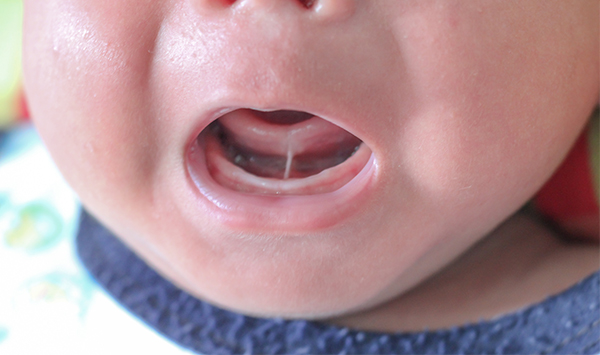Tongue/lip ties restrict normal mouth movement due to a short band which attaches the tongue or lip to the jaw.
The extent to which tongue or lip tie causes clinical symptoms has long been a subject of controversy. Some practitioners believe that no ill effect will result. However, a growing body of practitioners now thinks that limited movement may contribute to the feeding, speech, jaw development and mechanical problems.
What is tongue tie?
Tongue tie is defined as ‘embryological remnant of tissue in the midline between the undersurface of the tongue and the floor of the mouth that restricts normal tongue movement’. It is estimated as many as 4% of people globally have a tongue tie or restriction; however, due to the confusion of correct diagnosis, this number may be higher.
The incidence of tongue tie in adolescents and adults, and their frequency, have traditionally been overlooked. Mechanical (non-speech-related) symptoms and social concerns due to impaired tongue mobility are typical and may not become apparent until much later in childhood or even adulthood. Tongue tie is not just about being able to suckle as a child. Ankyloglossia symptoms should be taken into account and looked for in every assessment of jaw development and functional problems. The tongue may also play a role in craniofacial pain situations.
Severe tongue tie is usually picked up at birth or soon after due to breastfeeding problems. However, diagnosis of tongue tie is not as straight forward as we would like it to be. Humans are unique, and the same situation may present differently in different patients. Furthermore, some forms of restriction can not be identified until co-operation from the patient can show the level of restraint. These have traditionally been classified as anterior (front) that is easily visible and posterior (back) that is difficult to see. However, even if there is a band visible, the tightness of the band may not have a restrictive effect or other muscles of the face adapt during speech and swallowing to compensate for the tie. Many patients have a restricted tongue that is not picked up early as they have been able to change their speech and to swallow at an early age.
Why does a tongue tie matter?
Tongue-ties can contribute to lowered tongue posture and have now been identified as a risk factor for obstructive sleep apnoea. It is challenging to identify and quantify the level of the tongue tie present, and many criteria exist. Due to this confusion, a lot of practitioners try and stay away from the diagnosis as part of the bigger picture.
Also, with the lower tongue position and the resulting lower jaw position, migraines, chronic headaches, and neck tension has been reported to improve when the tongue restriction is released.
For this reason, it is imperative to bring children as young as two months for an assessment to correct any issues and ensure healthy development.
We believe that the tongue is to live in the roof of the mouth if proper growth of the top jaw is to happen due to the 2000 times we swallow a day. With tongue tie, we may also find more tongue thrust on swallowing and an open bite in the front teeth as a result. Alternatively, the restricted tongue does not apply pressure on the spot on the roof of the mouth and stimulate proper forward and sideways growth of the upper jaw that is needed to fit all our teeth into the bone.
Tongue tie symptoms
Babies
It seems to be a lot easier to diagnose babies with tongue tie; however, sometimes, additional advice is needed with the following:
- Issues latching
- Sucking blisters
- Long feeds
- Persistent grazed nipples
- Clicking sounds when feeding
Children
Traditionally the only criteria used was to assess if a child can suckle and if speech problems exist, but we look at more than this, including the following:
- Feeding difficulty: Breastfeeding, bottle feeding as well as solids
- Poor chewing and swallowing
- Food gulped down with drinks or water
- Food debris is often left around the mouth and easily aspirated resulting in coughing – often causing respiratory problems in babies, kids and adults
- Apparent hyper-salivation or dribbling – as a result of ineffective swallowing
- Regurgitation/gastrointestinal reflux causing heartburn
- Oral hygiene, dental health and dentition can be affected
- Tongue thrust causing an open bite
- Speech impairment
- Lowered tongue position causing developing of the mandible and underdevelopment of the maxilla due to the wrong swallowing pattern
- Mandibular or bony growths the lower jaw on the tongue side are also frequently found in patients with the tongue tie, pushing the tongue even further back affecting the airways
- Self-esteem and self-image issues due to frustration of tongue tie with behavioural problems: messy table manners, slow eating habits, over sensitivity to texture of foods, and splashing when talking.
Adults
Many adults live life without a tongue tie diagnosis due to the ability of the body to adapt; however, over time, the adaptation may be compromised or cause-related problems like:
- Difficulty with clear speech or mumbling
- Lisping on words
- Jaw pain or clicking or popping of the jaw
- Issues with dental disease
How is tongue tie treated?
Regular tongue movements help to spread out the roof of the mouth and widen the jaw, allowing for adequate room for teeth. We assess the mobility of the tongue and may prescribe tongue exercise to stretch the tongue tie. Still, in some cases, surgical intervention may be required in conjunction with tongue exercises. The exercises are essential in the healing process after the surgery to limit the scarring and further limiting of the tongue movement after healing.
Tongue tie pictures

What is a lip tie?
Lip tie restricts the lip movement and can affect speech; however, the most significant effect is the pushing apart of the upper teeth creating a gap.
Lip tie treatment
We all have this band that connects the lip to the bone, but some are over-pronounced, and these sometimes need to be released with surgery.
The procedure is relatively straight forward and with few complications.
The recovery can take 2-10 days with minor discomfort – relieved by painkillers. It is recommended to have tongue exercises or speech therapy immediately post-surgery to heal with more midget scar tissue.
Tongue and Lip Tie Sunshine Coast
If you or your child have experienced uncomfortable or painful symptoms due to tongue or lip tie, be sure to contact our team to organise an assessment.

